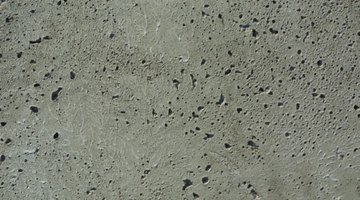How to Use Rock Salt to Creatively Finish Concrete
Concrete is a widely-used paving choice due to its versatility and durability. It can be formed into virtually any shape or design, and it can be finished in a nearly endless variety of colors and textures to match any theme or decorating style. One easy texture to apply to fresh concrete is a rock salt finish. This process leaves a pitted surface with the look of weathered rock, and it requires few additional tools or materials, keeping costs low.

Things You Will Need
- Freshly-poured and finished concrete
- Rock salt
- Concrete trowel or roller
- Broom
-
Press a finger into the concrete to test its readiness for salting. Your finger should depress the concrete about 1/4 inch, and no concrete paste should stick to your finger. A broom or float finish should already be complete, and the bleedwater should have evaporated from the surface.
-
Scatter the rock salt onto the concrete surface, taking care to get even distribution. Use more salt for a highly pitted surface. Typical application rates range from 3 to 12 pounds per 100 square feet.
-
Press the salt into the concrete using a trowel or roller. The salt crystals should have half their diameter remaining above the surface.
-
Sweep off the rock salt after the concrete has completely hardened, and remove it from landscape areas. Embedded particles that remain will dissolve with rainfall, or they can be removed by hosing down or pressure washing.
Tip
Choose the grade of rock salt depending on the desired final appearance. Larger grades of salt will leave larger pits in the concrete. Typical size is 1/8 inch to 3/8 inch diameter crystals. Rock salt can be combined with other texturing methods, like stamping or broom-finish, to create a unique look. If rain is expected soon after salting, cover the area with plastic to prevent the salt from dissolving before the concrete hardens completely.
Warning
This finish is not recommended for areas of the country where freeze-thaw conditions occur. Water accumulating in the pits may freeze and cause cracking or flaking of the concrete. Rock salt may cause staining of colored concrete. A textured roller or mat is preferred in this case. Large expanses of concrete should be poured in sections to allow easy access for salting.
References
Writer Bio
Based in Orlando, Fla., Jim Ford started writing in 1980 for the "Rock Island Argus" newspaper in Illinois. He has been accredited as a Florida Certified Nursery Professional and has an Associate of Applied Science in horticulture/natural resources from Kirkwood Community College in Iowa.
Photo Credits
- Photos.com/Photos.com/Getty Images
- Photos.com/Photos.com/Getty Images
More Articles



